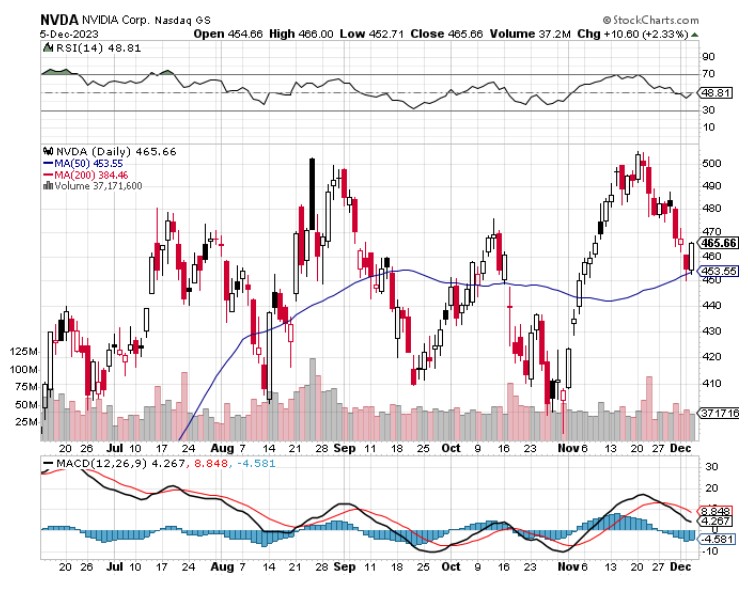(NVDA), (AAPL), (MSFT), (GOOGL), (AMZN), (AMD), (INTC)
Remember when Apple (AAPL) swaggered into the trillion-dollar club in 2018, strutting out as the first company to hit that mind-boggling market cap?
Back then, it seemed like a peak had been reached in Silicon Valley, a modern “Valley of the Kings” where tech titans rule the economic world.
In the ever-evolving realm of Silicon Valley, financial titans don’t just join the trillion-dollar club; they redefine it. We've now got six behemoths, each commanding their empires past the trillion-dollar mark.
Apple leads this charge with a whopping $2.97 trillion market cap, trailed by Microsoft (MSFT) at $2.78 trillion, Alphabet (GOOGL) at $1.66 trillion, and Amazon (AMZN) at $1.51 trillion.
Fast forward to now, and this valley is witnessing a new sovereign rising to power - Nvidia (NVDA).
This semiconductor giant, not one to shy away from a growth spurt, recently posted numbers that'll make your head spin. Their revenue nearly tripled last quarter, riding high on a wave of demand for chips powering artificial intelligence (AI) applications.
With a stock split in July 2021 - a 4-for-1 move, their fifth since hitting the public markets in 1999, Nvidia’s growth trajectory seems set for the stars, especially with AI being the industry's hot ticket item.
As for their stock, it’s ablaze, having skyrocketed 211% year to date.
A deep dive into their figures reveals a 206% surge in third-quarter revenue to $18.12 billion.
This growth is thanks largely to their data center business and those fancy AI chips like the h100 and a100.
Evidently, Nvidia is doing more than riding the AI wave – they are at the forefront, driving its momentum.
The generative AI market is projected to hit a cool $1.3 trillion by 2032. And Nvidia, supplying the chips that make the magic happen, is sitting in a sweet spot for sustained growth.
Nvidia's price-to-sales (P/S) ratio is a lofty 26, shadowing the S&P 500's average of 2.5.
But before you balk at that figure, consider this: it doesn't quite capture Nvidia's rapid growth and hefty net income margin, which was over 50% in the third quarter of 2023.
Plus, their forward price-to-earnings ratio is a more palatable 24, suggesting that investing in Nvidia might just be the shrewdest move for those looking at the long game in AI.
Looking back, it’s clear that 2021 has been a banner year for Nvidia's GPUs, the go-to for AI projects from language model training to inference.
However, Nvidia's not running a solo race here.
Microsoft recently unveiled its Azure Maia AI Accelerator chip, while Amazon just announced its next-gen Trainium AI chip. And don’t forget the likes of Advanced Micro Devices (AMD), Intel (INTC), and Google, all busy in their labs.
Attempting to dethrone Nvidia? It's proving to be a formidable challenge.
The robustness of technology underpinning Nvidia's platforms proves their dominance in the field, with the company holding an 86% share of the market. Why? Three big reasons.
First, they've got the most mature AI tech in the game. They’ve spent over a decade refining their CUDA software programming ecosystem.
Second, Nvidia is cloud-agnostic, allowing customers to hop from one cloud to another, unlike Amazon or Google's chips.
Finally, developers stick with Nvidia for its stability, market share, industry-specific tools, and reputation for backward compatibility.
So, who's the king of the hill in our modern-day “Valley of the Kings,” (aka Silicon Valley)?
It’s still a battleground where the mightiest of tech titans clash, and right now, Nvidia is the one wearing the crown, and wearing it with a certain flair, I might add.
But, as the tech world spins on, with AI carving out the future, remember this – in the Valley of the Kings, it's Nvidia's throne, and they're not giving it up without a fight. In this land of tech titans, they're the ones calling the shots... at least for now.



